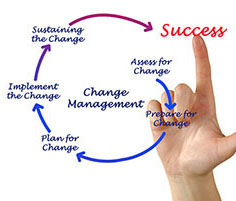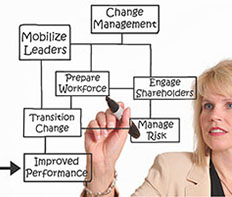Change Management Models
Change management is a people focused craft that draws on your communication capabilities and your political savvy to help you guide change through an organization. Part of leading change is about having a change process to follow, this good process will help you to engage your stakeholders, build momentum and organizational support to identify and overcome resistance to change.
Currently the dominant change management models that will help you to develop a change management process are
Now, let’s take a look at each change management model in more detail
ADKAR Developed by Prosci
ADKAR is a sequential change management model, developed by Prosci, that when followed transitions a person or team of people through a change.
- Awareness – of the change and the organizational reason for the change
- Desire – engaging peoples desire for the change through leadership, emotional appeals and resistance management strategies
- Knowledge – through training or coaching providing the employee/s with the knowledge of how to do their jobs after the change has occurred
- Ability – The practical application of the knowledge in the workplace, which may require considerable additional coaching
- Reinforcement – providing reinforcement for the change from praise for early adopters to celebrations
ADKAR is also considered to be a useful tool for
- Assessing poor performing change, if you can pinpoint the element of the model where people are stuck you will be able to develop strategies to help move people through the change process
- Developing change management plans to move people through the change
- Measuring the progress of your change
Essentially, for a change to be successful you need to transition people through each of the steps of ADKAR in order.
Prosci
Prosci is a three-step change management model supported by extensive tools, techniques and resources that is scalable to different change scenarios.
If you are keen to develop strong change management competencies then it would pay you to visit Prosci and brows their site. (Prosci is proprietary so we cannot give away their secrets to you here) The Prosci 3 phase change management process overview
Phase 1: Prepare for the change
In the first phase you will gain an understanding of the change, who the major stakeholders, develop the change strategy and ensure all people with a role to play in delivering the change are aware of their role and equipped to play their role. In this phase you may also identify some areas where resistance to the change could be reasonably anticipated.
Phase 2: Managing the change
In the second phase you will develop and execute a number of plans to support people through the change, see ADKAR, these plans include communication, training coaching, resistance management plans. More importantly you will communicate with stakeholders and engage impacted employees in the change planning and delivery.
Phase 3: Reinforcing the change
In the final phase you will follow up on the change implementation by measuring the adoption of the change through collected feedback from impacted employees, audit and observation to identify areas where the change has gone well and areas where there are some gaps or pockets of resistance. You will also intervene to overcome the gaps to ensure the change is a success
Kotter’s 8 Step Model
Kotter was one of the first to identify the need for a holistic approach to the management of change and after extensive research identified an eight step change management model. The eights steps are
Step 1: Establishing a Sense of Urgency
Establishing a sense of urgency requires you to link the change to the organizations long-term goals, enlisting senior managers/executives to publicly support the change. A little is about knowing when to drive the change by making sure you change has a clear run and will not get sidelined due to another activity that is already in play.
Step 2: Creating the Guiding Coalition
With your sense of urgency and the support of senior managers and executives establish a team to deliver the change, the leaders of the people who are required to change. Let this team know what is expected from them and provide coaching on how they can help lead the change.
No change will work if the change manager does not build a strong team to deliver the change.
Step 3: Developing a Change Vision
Create a vision for the change by engaging those impacted by the change in developing the vision (Probably just the leaders of those impacted). Set aside your personal preferences and develop a vision that resonates with the impacted employees.
Again check for obstacles and keep the path clear
Step 4: Communicating the Vision for Buy-in
Then communicate the vision and get others (senior managers) to communicate the vision broadly in the organization, verify that people understand the vision and will support the vision. Whilst communicating the vision be on the lookout for resistance, as it will start to become more visible.
Step 5: Empowering Broad-based Action
Empowering action is making it possible for people to adopt the change, removing organizational obstacles such as structure, KPI’s, reporting processes and other elements of the organization that are inconsistent with the change that you are seeking.
Step 6: Generating Short-term Wins
Include in your planning some short-term gains or wins to help build momentum and celebrate these wins. Have senior leaders talk bout these wins in meetings and informally to staff. Your short-term wins will increase the probability of others embracing the change and will reduce resistance to the change in other areas of the business.
Step 7: Never Letting Up
Never letting up is all about holding steady and reinforcing the vision, soon after a change has been implemented people will revert back to old ways if you take your eye of the ball. It is important to keep your messages alive and monitor the change for many months after the change is implemented. This can be done via audit, reporting progress or in discussion with impacted areas.
The next wave of change can also help reinforce the last change.
Step 8: Incorporating Changes into the Culture
Incorporating the change into culture includes ensuring the management systems have the change embedded. These management systems include policies, procedures and work instructions, reporting and audit processes and in informal and formal communications.
Lewin's Three Step Model
The change Management model developed by Lewin has three phases to it that are quite simple to understand and have a ring to them that appeals to myself. The three steps in Lewins model are
Step 1: Unfreeze
The existing way of doing things is considered frozen in the organizations culture, systems and practices and that needs to be thawed so that the organization can change.
Unfreezing requires you to understand the “as is” and the compelling reason for the change to take place, establish strong support for the change and communicate the reasons for the change and finally listen to employee concerns and address their concerns.
Step 2: Change
Now that the organizations is “unfrozen” it is open to change so you will need to communicate often and in many ways, bust myths or rumors that emerge, empower actions through involvement and participation.
Generate and celebrate short-term wins and reinforce the change.
Step 3: Refreeze
Refreezing is about embedding the change into the companies culture and systems of work. Updating policies, procedures and work instructions, KPI’s measurement systems and management reporting.
Where necessary adapt the organizations structure, create reward systems and provide support and training to all impacted employees
Change Management Model Summary
Each change is unique and requires a different approach to the last change it is only through an understanding of each of the change management models that you will be adaptable to all change management scenarios.
You will see that ADKAR is a model for individual change it focuses on the transition of a person or team of people through a change and does not address the organizational changes supporting the change, however Prosci, Kotter and lewins are all models of organizational change.
Whilst there are differences between these three organizational change management models you will find that they map loosely together. This mapping is shown in the table below.
Prosci |
Kotter |
Lewins |
Phase 1: Prepare for the change |
Step 1: Establishing a Sense of Urgency Step 2: Creating the Guiding Coalition Step 3: Developing a Change Vision |
Step 1: Unfreeze |
Phase 2: Manage the change |
Step 4: Communicating the Vision for Buy-in Step 5: Empowering Broad-based Action Step 6: Generating Short-term Wins |
Step 2: Change |
Phase 3: Reinforce the change |
Step 7: Never Letting Up Step 8: Incorporating Changes into the Culture |
Step 3: Refreeze |







